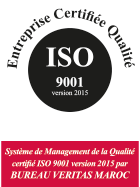
Helmets, fluorescent vests and reinforced shoes. On Monday May 6, the Mohammed VI Foundation for Science and Health organized a special site visit to its future university hospital complex, currently under construction on a 280,000 m² site in Rabat. Ultimately, the site will bring together the Mohammed VI International University Hospital (HUIM6-Rabat) and the Mohammed VI University of Science and Health (UM6SS-Rabat), forming an integrated complex dedicated to healthcare, teaching and research. The site already gives an idea of the project’s ambitions.
The architecture is designed to be scalable: “ If a department needs to expand tomorrow, we don’t have to break it down to rebuild ”, said Ahmed Bennana, General Manager of the Rabat hospital complex. This logic of adaptability also applies to equipment, such as the operating theatres, still empty, but designed to accommodate twenty rooms, one of which will be robotized. All will be connected to a centralized supervision room, a “ control tower ”, where experienced surgeons will be able to remotely monitor, guide, and even intervene if necessary. A 25-storey hospital tower completes the compound. Some 4,500 people are currently working on the site. The economic impact is already visible. Ultimately, the complex should attract a large number of medical and paramedical profiles, including Moroccan practitioners living abroad. The attached university (UM6SS-Rabat) will include a Medical School, a School of Engineering in Health Sciences, a Nursing School, as well as two units currently under development: Pharmacy and Dentistry. A simulation center will occupy an entire wing, with humanoid mannequins and technical platforms. “The principle is simple: never the first time on a patient”, reminds the director. From their very first year, students will be immersed in hospital operations: procedures, flows, protocols. The aim is to “train professionals who are rooted in the reality of care”. The site also aims to have a regional reach, notably through the creation of the African Academy of Health Sciences, which is intended to structure exchanges and training on a continental scale. Initially, the hospital will have 600 beds, which can be extended as required. The system will be entirely digitized, with connected bracelets, traceability of patient care, analysis of operating times and remote supervision. Artificial intelligence will be used for certain aspects of diagnosis and flow management. In addition to its technological ambitions, the Foundation insists that the project should be firmly rooted in the Moroccan healthcare landscape.
Amine Rboub


























